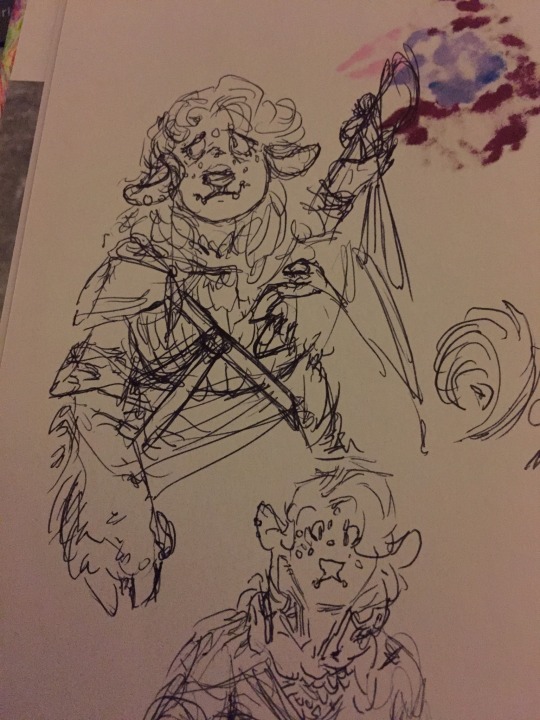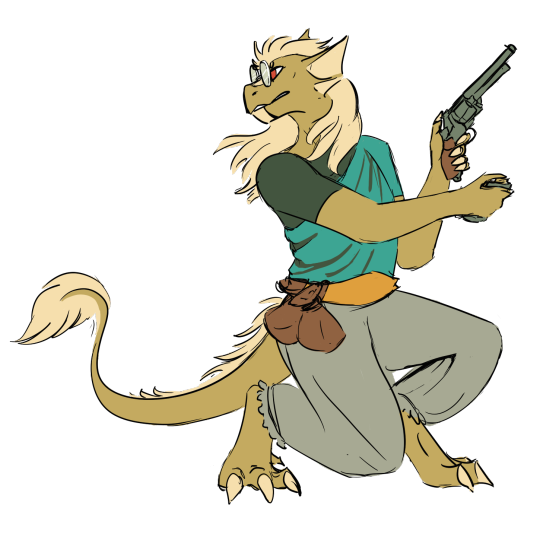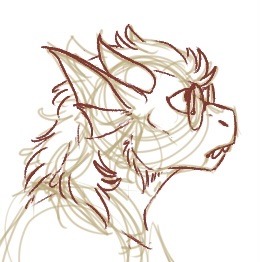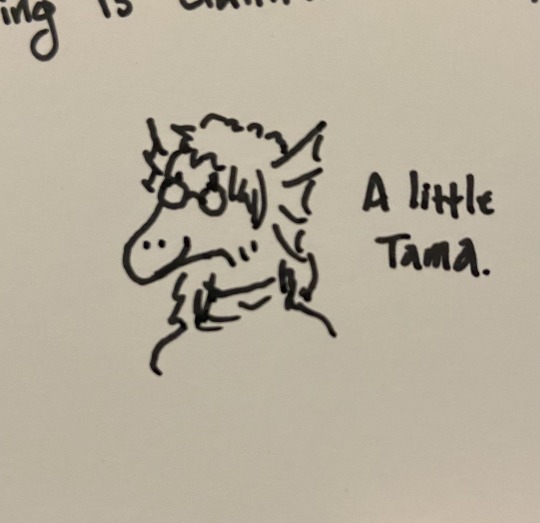#sometimes you ship of theseus a lizard
Note
if you want to! tell us more about your lizard PCs because i’m so angry on your behalf from those tags
ohhhh i will HAPPILY talk about my old lizards, Especially the First Lizard, Avra Ree, because Avra Ree went on a fucking Journey.


So this! Is Avra Ree, she was a copper dragonborn and a death cleric, and she was my First Ever DnD Character. She was a fucking mess, both wrt stats (because none of us knew what we were doing; fucking TAZ:Balance taught me more about mechanics than my group at the time, and Balance was. Hooo boy.) and in terms of group cohesion, but that’s okay, because I loved her!
The gist of Avra was that she came from a clan of dragonborn that worshipped a goddess of death and rot. It was a heavily isolated group, and in leaving it to go on a pilgrimage, this would be Avra’s first time encountering the new world around her. She was full of love and joy, and she was Terrified of rain and water. She was a mortician, and regarded death with a certain gentleness and love. She also had a brother, who died from illness at a young age; she never really moved on from the grief, and kept his skull, which she kept with her and used as a spell focus.
The core themes of Avra’s character were isolation, love, and grief.
I’d play her like a few more times over the years (once in another campaign that never really took off the ground, and a few more times in one-shots) but it wouldn’t be a while until she came back.
In February of 2019, my buddy Hollis wanted to run a campaign. We were RP partners at the time! I went yea sure count me in!!!!!!
I knew I wanted to play Avra again, but I kinda wanted to mix up her design after the last few years of Lizard. so ENTER!!!! Marvey!!!!!!



Avra Ree would be rewritten as a firbolg grave cleric named Himemiya “Marvey” Llue.
Over the course of Everything, there’d been more lorework and detail given to her backstory and the setting of it.
She’d be from a clan of firbolg living in an archives that once was the hoarde of an ancient silver dragon, which was regarded as the savior of their people. They were dedicated to the preservation of knowledge above all else. Though the Great Dragon was long dead by the time Marv came about, the logul people were dedicated to the preservation of the hoarde and its expansion! On occasion, people would leave the mountain to go back out into the world and gather more books, articles, papers, newspapers, paintings — anything they could get their hands on, really. Go out, learn more about your field of study, come back and report what new discoveries had been made, if any.
Marvey’s mother would leave on a pilgrimage. She’d leave her kid and her husband behind with bright eyes and promises to be back in a few years, and then she never came back. So! Later on. Marvey would also leave. Head out into the world, find out what happened to her mother and maybe find some closure.
She’d become a cleric of Jergal, after finding a dilapidated temple of his that’d been taken over and inhabited by all sorts of imps and other nasty critters + helping clearing it out and tidying it up.
Core themes of her character were once again love, death, grief, and isolation, and some of her central conflicts revolved around trauma as a result of heavy childhood neglect, (more) grief, and also unlearning harmful shit from your upbringing and environment.
Also? Anger. Oh my god. Anger.
Marvey had ! Many, many issues. There was a big conflict between her and another party member early on that neither one of them really recovered from, and it ended up becoming a big issue that was slowly driving the party apart. Marvey was also fucking, deeply deeply angry and felt things VERY intensely, which ended up causing a lot of problems vis a vis character bleed for me, and it ended up negatively impacting my mental health to the point where we made the hard decision to let Marvey go + start playing another character.
We never found Marv’s mom, and Marv never got her closure.
Instead, Marv joined the mafia. She now — post campaign — acts as a doctor for the mob + runs a small community clinic by herself. She’s a fixture of her newfound community, and she’s fiercely protective of this small corner of the city she’s made for herself.
HOWEVER.
Avra Ree had a Real Cute Design, didn’t she? And I kinda wanted to play a lizard again after so many years. I made a lot of mistakes with Marvey; she was a source of conflict, when I wanted her to be more soft and warm, the glue that holds the party together. So when Marvey and Ish (Marv’s replacement)’s campaign ended, we decided to return to lizard.
Enter: Tamara Bhatt



This is Tama, my sweet beloved Tama. I love her So Much. She’s a brass dragonborn gunslinger/rogue. She is!!! Just A Guy! And i’m Insane about her.
She’s the oldest of five, and she comes from a very small town. She left home to head north into her country’s capital to apprentice under a weaponsmith. The way that she joined the party/campaign? Her mentor was having her deliver a package in person to one of their clients (an npc named Yu Huang, a famous actor and important political heir a few countries over. Tama and Huang would later become Best Fucking Friends.)
She’s Just A Fucking Guy, but she’s got some of The Best characterization I’ve EVER done, and I just really have a fucking blast playing her. I love this lizard so much. She’s just a guy. Just a small town lizard who went into the Big City to deliver a package, met some people, and now she’s so thoroughly entangled in this deep web of conflict with no way out. To protect one of our party members, our only options are to Get Famous, or Die Trying, and now? Tama’s in far too deep.
If I had to assign her core themes, they’d be identity, what it means to be brave, family, and isolation vs community. And Love, of course. You can fit So Much Love in this lizard.
It’s been really interesting though! Because Avra most certainly became Marvey, but Tama’s character was certainly informed by mistakes I made with playing Marv. Marv was a character who would’ve been really fun to read in a story, sure, and I love her to bits! But ultimately, she wasn’t a character well-suited for an improvisational cooperative game. She was too heavily developed, and it made her incredibly rigid. She was sweet and friendly, but INCREDIBLY stubborn and Driven. I wanted her to be a stabilizing force for the party, but she ended up becoming a source of conflict.
With Tama, though? I’ve actually managed to succeed! Tama is likeable! She’s the Big Sister of the party, the one people turn to for comfort, the mediator. There was a two-session gap where Tama actually died during combat, and her body had to be left behind, causing a lot of uncertainty and grief in the party because That’s Tama, and We Left Her Behind, and What If We Never Get Her Back? and ngl, it was genuinely Fascinating to see the hole Tama left in the party, because her absence was VERY MUCH felt!!!! You could see the arguments play out and all the spots where Tama would usually step in and help work things out, and it was ROUGH!!!!!!
But ! Idk man, I just think its Neat. That’s the story of my first DnD character, Avra Ree, who paved the way for Marvey and Tama, all three of which who are Distinct, but also kinda overlapping still. Its neat!
#sometimes you ship of theseus a lizard#and you end up with three distinct characters#one of which is actually a cow (firbolg)#this is the rough and quick of it though!#i started playing avra in……..2016? marv i began playing in feb of 2019 and tama i began playing in july of 2021#tobi talks#marvey#tama#SORRY IT TOOK ME A MOMENT TO SEE THIS KEEBS#deerkibble
6 notes
·
View notes
Text
The Accumulation of Small Changes
In a story, the Greek hero Theseus leaves for a long sea journey. During his voyage, one by one, each plank of the ship was broken and replaced as the ship travelled from harbor to harbor; the sails ripped and new ones were raised; masts burned and new ones set in their place; supplies exhausted and replenished. Every man of the crew, one by one, decided to stay on one exotic shore or another, caught some disease or tasted the blade of a sword, and all along new members joined and were hired.
When all was said and done, and the ship made it back home, none could recognize it. It shared nothing in common with the ship that had left the port decades before.
Was it the same ship that left? And if not, when did it stop being the same ship?
One can imagine countless variations of this thought experiment, commonly known as the Ship of Theseus. What if you could salvage the original parts of the ship and rebuild it, would that be the original ship, or would the ship that arrived at the port be the original? What if two sister ships left each on their own journey, and came back vastly different, at which point did they stop being ships of the same make?
The questions are of course largely rhetorical. The truth is, there is no ship. There are only atoms. But we can't respond to that which we don't recognize, and we can't recognize that which we don't categorize. Things separated by only small differences fit in the same box, while those with large differences belong in different boxes. The trouble comes when small changes accumulate into large ones.
The accumulation of small changes is core to the theory of evolution. It is an observable fact that children are slightly different from their parents, but only slightly: human parents give rise to human children. Siblings are more similar to eachother than first cousins, who are closer than second cousins, but all still the same species. But eventually the differences are way too big for to fit our boxes: a dolphin and a hippopotamus, while very different, are simply distant cousins, a relative stone's throw away in evolutionary terms.
Of course the dolphin's mother was still a dolphin, and so was the hippo's mother. So were their mothers' mothers and mothers' mothers' mothers. In fact, every mother in that chain was the same species as her daughter and the same species as her mother. Yet, somewhere along the dolphin's chain, we find animals that aren't dolphins, and eventually animals that aren't even whales. Yet at no point do we find a non-dolphin giving birth to a dolphin, or a non-whale giving birth to a whale. Each change is subtle, but just because a single step doesn't carry you far doesn't mean ten thousand can't.
At some point in the chains, the distant ancestors of the dolphin start to look almost indistinguishable from the distant ancestors of the hippo. Eventually, the chains are connected: one daughter of this four-legged, amphibious creature would go on to be the ancestor of the dolphin, and in fact of all dolphins. Another daughter could trace its descendants down to the hippo, and all hippoes everywhere. Yet they share a striking resemblance to their mother and each other, and little resemblance to their eventual progeny.
Even more confusing is the concept of ring species: a species is traditionally defined as a group of organisms that can produce viable offspring. But this definition too has its limits: if lizards of subspecies A can breed with those in subspecies B, which can breed with those in subspecies C, the members of A and C might be too different from each other to crossbreed! Thus As are the same species as Bs, which are the same species as Cs, but Cs aren't the same species as As. It is like a ring with a section missing, whence the name.
"Species" are thus not something that is inherent in nature. It is a way for us to satisfy our desire to categorize. Often it is useful; sometimes it produces only confusion.
Another phenomenon that works much like life is language. Anyone who has ever read Shakespeare can attest that the English language has changed in great ways across the centuries. In fact that change continues now too, just slow enough that you can convince yourself the language is staying in essence the same. And decade to decade, it is. Just not century to century.
The word "word" can trace it's lineage back to the word "werdʰh₁om" sharing the same meaning, 4000 years ago, all the way back in the language only known as "Proto-Indo-European", dialects of which would go on to become Latin, Greek, Sanskrit, and indeed English, Russian and Hindi.
"Werdʰh₁om" would develop in one dialect into the Proto-Germanic "wurdą", from which came the English, German, Swedish and Dutch words, among plenty of others. In another branch, it became the Proto-Italic "werβom", from which came Latin "verbum", from which English "verb" was borrowed.
So when did English diverge from Proto-Germanic? When did Proto-Germanic diverge from PIE? Any answer more precise than a century or two will be unsatisfactory, because there is no moment at which a language stops being a distant dialect and starts being a close language. If you want to viscerally feel this as an English speaker, this video on the Scots language in said language is a great demonstration. There are even analogues of ring species in languages, known as dialect continuums, where all nearby people understand each other, but one end of the continuum is incomprehensible to the speakers of the other.
Even more interesting is the way stories can evolve by small changes. While some try to shock us by comparing Disney's retelling of Cinderella to the much more violent Aschenputtel by Brothers Grimm; but Disney's story was instead based on Cendrillon ou la petite pantoufle de verre by Charles Perrault, a much lighter and more fanciful version of the story.
Which version is then the original? Neither.
Both are well preceded by Cenerentola by Giambattista Basille, itself wholly different in the details from either of the stories that followed it. All are based in local variations in the story, as well as the authors' own embellishments.
Cinderella, more accurately its ancestors and cousins, have existed since time immemorial. In Ye Xian, a Chinese story written down around 860, a girl abused by her evil stepmother is dressed up in fancy clothes by magical fish bones to go to a festival, but has to run from it and accidentally loses her golden shoe. The shoe ends up in the hands of a king, who wanted to find who the shoe belongs to. When his search leads him to Ye's house, the king is instantly stricken by her beauty and they go on to marry.
At which point does a story become a different story, rather than a different version of the same story? By this point, you surely know that there is no answer.
Even my retelling of the Ship of Theseus, right at the beginning, is significantly embellished from the barebones thought experiment I originally learned, and even further changed from its original version, in which the ship is simply preserved as a museum piece, long after Theseus's time. So should it be further retold, the story itself will become an example of the very phenomenon it describes.
And wouldn't that just be appropriate.
0 notes